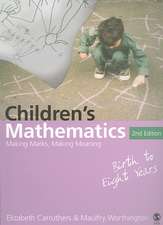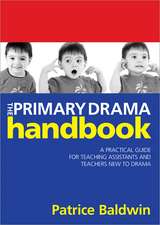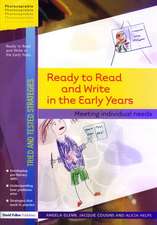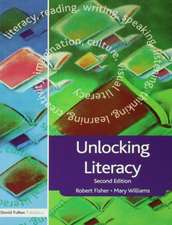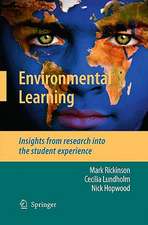Transformation - A Fundamental Idea of Mathematics Education
Editat de Sebastian Rezat, Mathias Hattermann, Andrea Peter-Koopen Limba Engleză Hardback – 13 dec 2013
| Toate formatele și edițiile | Preț | Express |
|---|---|---|
| Paperback (1) | 647.08 lei 6-8 săpt. | |
| Springer – 27 aug 2016 | 647.08 lei 6-8 săpt. | |
| Hardback (1) | 651.51 lei 6-8 săpt. | |
| Springer – 13 dec 2013 | 651.51 lei 6-8 săpt. |
Preț: 651.51 lei
Preț vechi: 766.49 lei
-15% Nou
Puncte Express: 977
Preț estimativ în valută:
124.68€ • 135.39$ • 104.73£
124.68€ • 135.39$ • 104.73£
Carte tipărită la comandă
Livrare economică 23 aprilie-07 mai
Preluare comenzi: 021 569.72.76
Specificații
ISBN-13: 9781461434887
ISBN-10: 1461434882
Pagini: 230
Ilustrații: XXII, 409 p. 112 illus., 26 illus. in color.
Dimensiuni: 155 x 235 x 30 mm
Greutate: 0.73 kg
Ediția:2014
Editura: Springer
Colecția Springer
Locul publicării:New York, NY, United States
ISBN-10: 1461434882
Pagini: 230
Ilustrații: XXII, 409 p. 112 illus., 26 illus. in color.
Dimensiuni: 155 x 235 x 30 mm
Greutate: 0.73 kg
Ediția:2014
Editura: Springer
Colecția Springer
Locul publicării:New York, NY, United States
Public țintă
ResearchCuprins
Introduction to Part I.- How 18th Century Mathematics was Transformed into 19th Century School Curricula.- A Framework for Examining the Transformation of Mathematics and Mathematics Learning in the Transition from School to University: An Analysis of German Textbooks from Upper Secondary School and the First Semester.- Knowledge Transformation between Secondary School and University Mathematics.- Student Transition to University Mathematics Education: Transformations of People, Tools and Practices.- Overcoming the Gap between University and School Mathematics: The Impact of an Innovative Programme in Mathematics Teacher Education at the Justus-Liebig-University in Giessen.- Mathematical Moments in a Human Life: Narratives on Transformation.- Transitions in Learning Mathematics as a Challenge for People and Institutions.- Introduction to Part II.- Constructing Knowledge by Transformation: Diagrammatic Reasoning in Practice.- Transforming Images in a DGS: The Semiotic Potential of the Dragging Tool for Introducing the Notion of Conditional Statement.- Dynamic Representations of Complex Numbers: Opportunities to Learn in Teacher Training.- Dynamic and Tangible Representations in Mathematics Education.- The Role of Social Aspects of Teaching and Learning in Transforming Mathematical Activity: Tools, Tasks, Individuals and Learning Communities.- Designing a Simulator in Building Trades to Transform Vocational Education.- Discussion I from an Epistemological Point of View: Representing and Meaning-making: The Transformation of Transformation.- Discussion II from a Technological Point of View: Digital Technologies and Transformation in Mathematics Education.- Introduction to Part III.- From Proof Image to Formal Proof – a Transformation.- Elementary Stochastic Seeing in Primary Mathematics Classrooms – Epistemological Foundation and Empirical Evaluation of a Theoretical Construct.- Understanding Geometric Work through its Development and its Transformations.-Small Steps to Promote “Mathematical Literacy”.- Transformation as a Fundamental Concept in Arithmetical Competence Modelling: An Example of Informatical Educational Science.- Fundamental Ideas of Didactics – Reactions to the Suggested Meta-Theoretical Construct for Reflecting and Connecting Theories.- Epilogue.
Textul de pe ultima copertă
This book opens up a discussion on fundamental ideas of mathematics education as a means to focus on the overarching core issues and to reflect upon the identity of the scientific discipline. The concept of transformation is introduced as one fundamental idea in the discipline and examined from different perspectives. Transformations are related to knowledge, to signs and representations of mathematics, to concepts and ideas central to teaching and learning mathematics, and to instruments for the learning of mathematics.
With an international pool of authors, this book seeks to answer the following questions: What do we know about transformations in the different domains? What kinds of transformations are crucial? How is transformation in each case conceptualized?
The book is meant for researchers, teacher educators and curriculum designers in the field of Mathematics Education. It is destined to occupy an important place in current literature on the topic of transformation as a way of uncovering and explaining mathematical practice and the very essence of mathematics as well as a way of creating and maintaining semantic networks between different content areas.
With an international pool of authors, this book seeks to answer the following questions: What do we know about transformations in the different domains? What kinds of transformations are crucial? How is transformation in each case conceptualized?
The book is meant for researchers, teacher educators and curriculum designers in the field of Mathematics Education. It is destined to occupy an important place in current literature on the topic of transformation as a way of uncovering and explaining mathematical practice and the very essence of mathematics as well as a way of creating and maintaining semantic networks between different content areas.
Caracteristici
The principle of Transformation is used to shape discussions of mathematics theory Discontinuity in mathematics education is addressed and real world examples given to solve this problem Teaching and learning geometry provides a context for understanding transformation in mathematics education



